Intro: Beehiiv vs Substack at a glance (and a quick answer)
What this guide covers in 2 lines
You want the best platform for paid newsletters, growth, and control. We tested both tools end-to-end and compiled the must-know differences.
If you’re a creator running a serious newsletter business, you need to understand pricing, monetization, growth levers, and long‑term flexibility.
TL;DR
Choose Beehiiv if you want built‑in growth levers (referrals, boosts, ad network), advanced analytics/segmentation, and low platform fees as you scale.
Choose Substack if you want the simplest writing experience, social discovery via its network/Notes, and to start free - especially if monetization is purely paid subscriptions.
Looking beyond newsletter platforms? BlogBowl gives you a full SEO‑optimized blog + built‑in newsletter + AI content automation to grow organic traffic while you write less.
"Substack surpassed 3 million paid subscriptions in February 2024." - Source
Comparison at a glance (high-level features and who it’s for)
Feature | Beehiiv | Substack |
|---|---|---|
Who it’s for | Growth-focused creators, media brands, and SaaS teams treating newsletters like a business | Solo writers and creators who want the simplest, community-first publishing experience |
Pricing model | Tiered plans; $0 to paid tiers; $0 platform cut on subscriptions (Stripe fees apply) | Free to use; 10% platform fee on paid subscriptions (plus payment processing) |
Monetization tools | Paid subscriptions, native Ad Network, Boosts (paid recommendations), sponsorship workflows | Paid subscriptions as primary model; manual sponsorships/affiliate embeds |
Growth tools | Built-in referrals, Boosts marketplace, co‑registration, recommendations, magic links | Recommendations, Notes/social discovery, basic follow network effects |
Automation/segmentation | Visual automations, drip sequences, advanced segmentation by source/behavior | Minimal automation; basic segmentation (free vs paid) |
Analytics depth | Source-level, cohort and campaign analytics; advanced dashboards | Simplified analytics: opens, clicks, referrers, top posts |
Customization | Strong newsletter design controls; decent site customization | Minimal newsletter/site customization; uniform look-and-feel |
SEO/domain control | Custom domains, SEO fields (slugs, meta), structured hub for posts | Custom domains (fee-based), basic SEO fields; limited technical controls |
How we tested
Set up publications on both platforms and configured branding and domains.
Imported subscribers and sent multiple campaigns to benchmark deliverability and engagement.
Tested referrals, recommendations, boosts/ads, and paid subscription flows end-to-end.
Audited SEO controls, customization limits, and content portability.
Evaluated integrations, automations, and analytics depth for data-driven growth.
Decision cheat sheet: Which one fits your goals?
Pick Beehiiv if you:
Treat your newsletter as a business and want multiple revenue streams (ads, boosts, referrals, paid tiers)
Need segmentation, automations, and granular analytics
Plan to scale subscriber count without surrendering a platform fee percentage
Pick Substack if you:
Want the lowest lift to start publishing and monetizing with paid subscriptions
Value community features (Notes, comments, discussions) and network discovery
Don’t need advanced automations or heavy customization
Quick persona matches
Solo creator validating a niche → Substack
Media/brand with growth targets and sponsor revenue → Beehiiv
SaaS/startup focused on SEO + owned media hub → Consider BlogBowl for full blog + newsletter + AI content automation
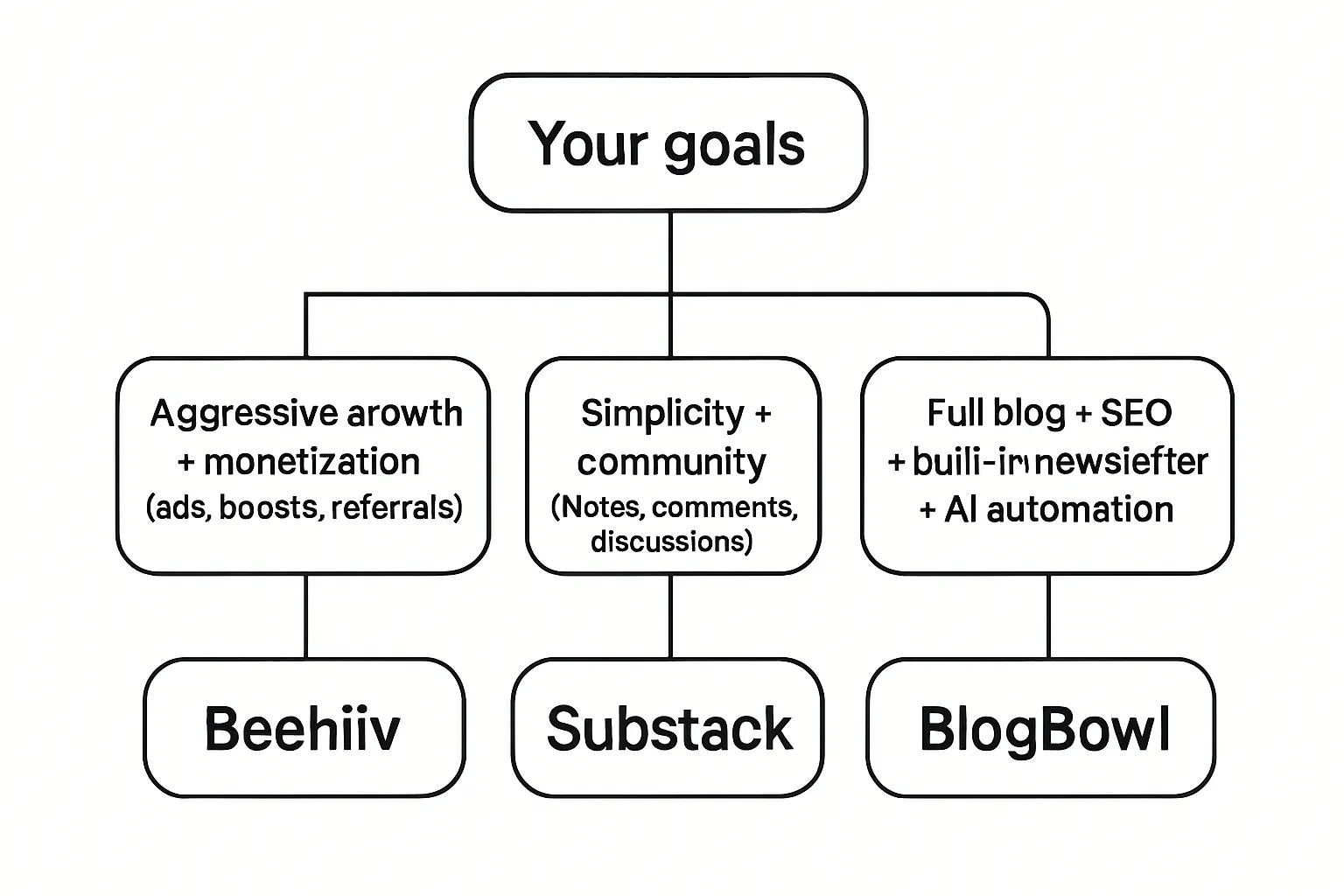
Pricing and fees (and the real break-even math)
Substack pricing model
Free to use until you charge; then 10% platform fee on paid subscriptions + payment processing fees
Works best when you’re small or staying free; becomes expensive with many paid subscribers
Beehiiv pricing model
Tiered monthly plans by features/audience size; 0% platform fee on membership revenue (standard Stripe fees apply)
Predictable costs; better for scaling paid subs, sponsorships, and ad revenue
Break-even scenarios you should run
Compare Substack 10% cut vs Beehiiv monthly fee at different paid sub counts (e.g., 500, 1k, 5k)
Where sponsorship/ads are your main revenue, Beehiiv’s 0% fee is advantageous
Paid subs | Assumed price per sub (monthly) | Gross monthly revenue | Substack platform take (10%) | Beehiiv monthly fee (illustrative) | Cheaper at this level |
|---|---|---|---|---|---|
500 | $10 | $5,000 | $500 | $49 | Beehiiv |
1,000 | $10 | $10,000 | $1,000 | $69 | Beehiiv |
5,000 | $10 | $50,000 | $5,000 | $109 | Beehiiv |
Assumptions (illustrative): paid plans priced at $10/month; Beehiiv plan fees approximated by audience tiers (e.g., ~$49 for ≤1k, ~$69 for ≤2.5k, ~$109 for ≤10k). Actual pricing varies by plan/features and payment processor fees.
Rule of thumb: break-even paid subs ≈ Beehiiv monthly fee ÷ (10% × price per sub).
Example: With a $69/mo plan and $10 pricing, break-even ≈ 69 ÷ (0.1 × 10) = 69 paid subs.
Don’t forget hidden costs
Time to set up growth engines vs. platform convenience (referrals, boosts, ad ops)
Whether you’ll need integrations/automation (often paywalled on Beehiiv)
Monetization: memberships, ads, boosts, referrals
Substack
Paid subscriptions (simple to set up; platform takes 10%)
Manual sponsorships possible (no native ad network)
Community tools can increase perceived value for paid tiers
Beehiiv
Paid subscriptions with 0% platform fee (Stripe fees only)
Native Ad Network for inbound sponsorships
Boosts (paid recommendations) to buy/grow subs
Referral program with rewards; pay‑what‑you‑want and lifetime options available on higher tiers
Practical advice
If you plan mixed monetization (ads + subscriptions + partner promos), Beehiiv compounds revenue streams out of the box
If your core model is premium content only, Substack’s simplicity can be enough early on
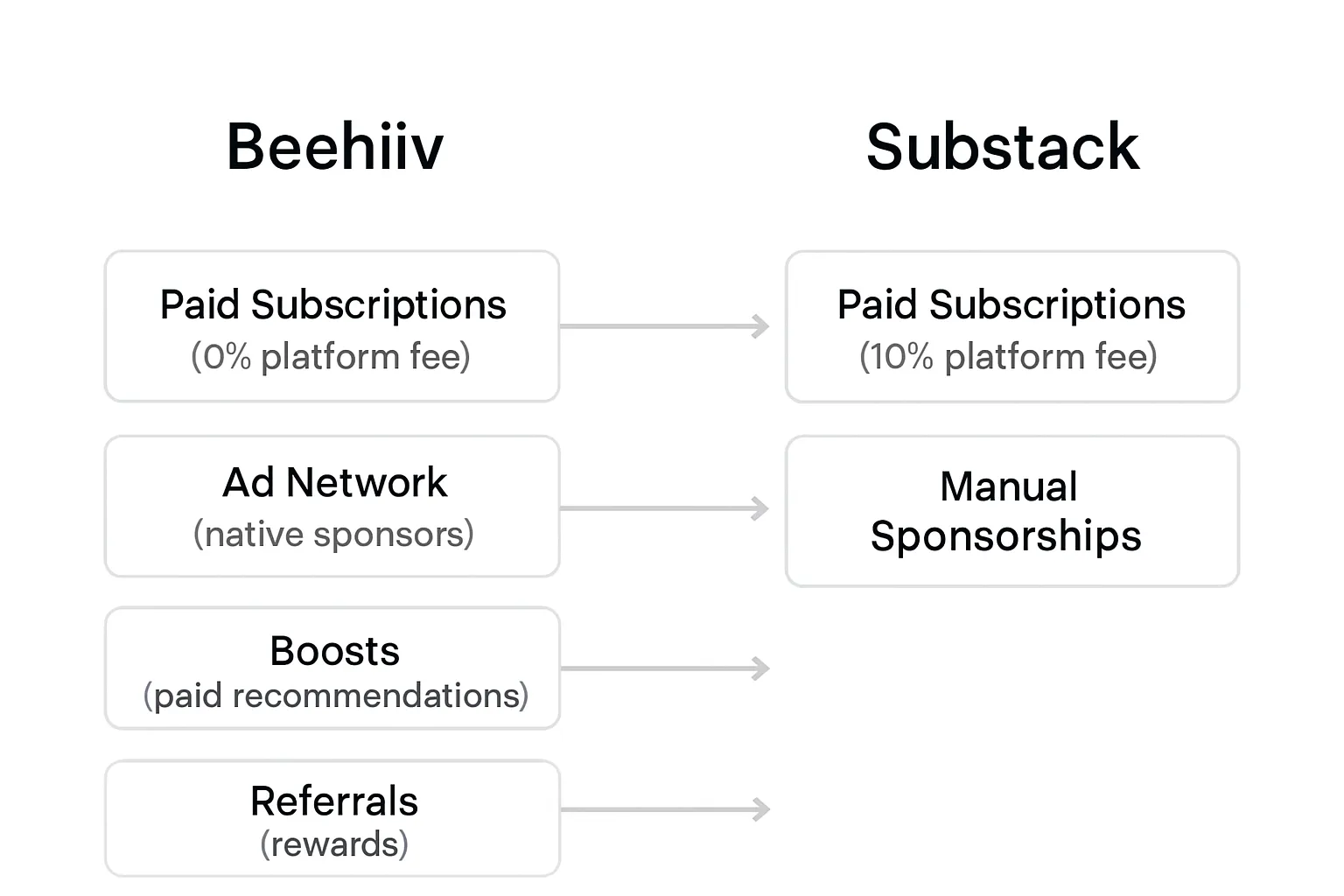
"beehiiv’s native Ad Network connects publishers with premium advertisers, and Boosts enable paid recommendations to grow or monetize audiences directly inside the platform." - Source
Growth and discovery: network effects vs growth stack
Substack’s discovery engine
Notes, recommendations, discussions, comments, and follows
Strong internal network can surface your publication to new readers
Beehiiv’s growth stack
Native referral program with tiered rewards
Boosts for paid recommendations and subscriber acquisition
Magic links for one‑click opt‑ins; A/B tests for subject lines
Which grows faster?
If you can leverage social network effects and write for a creator‑centric audience, Substack’s built‑in discovery helps
If you have a budget and want controlled, trackable acquisition with analytics, Beehiiv’s Boosts + referrals are purpose-built
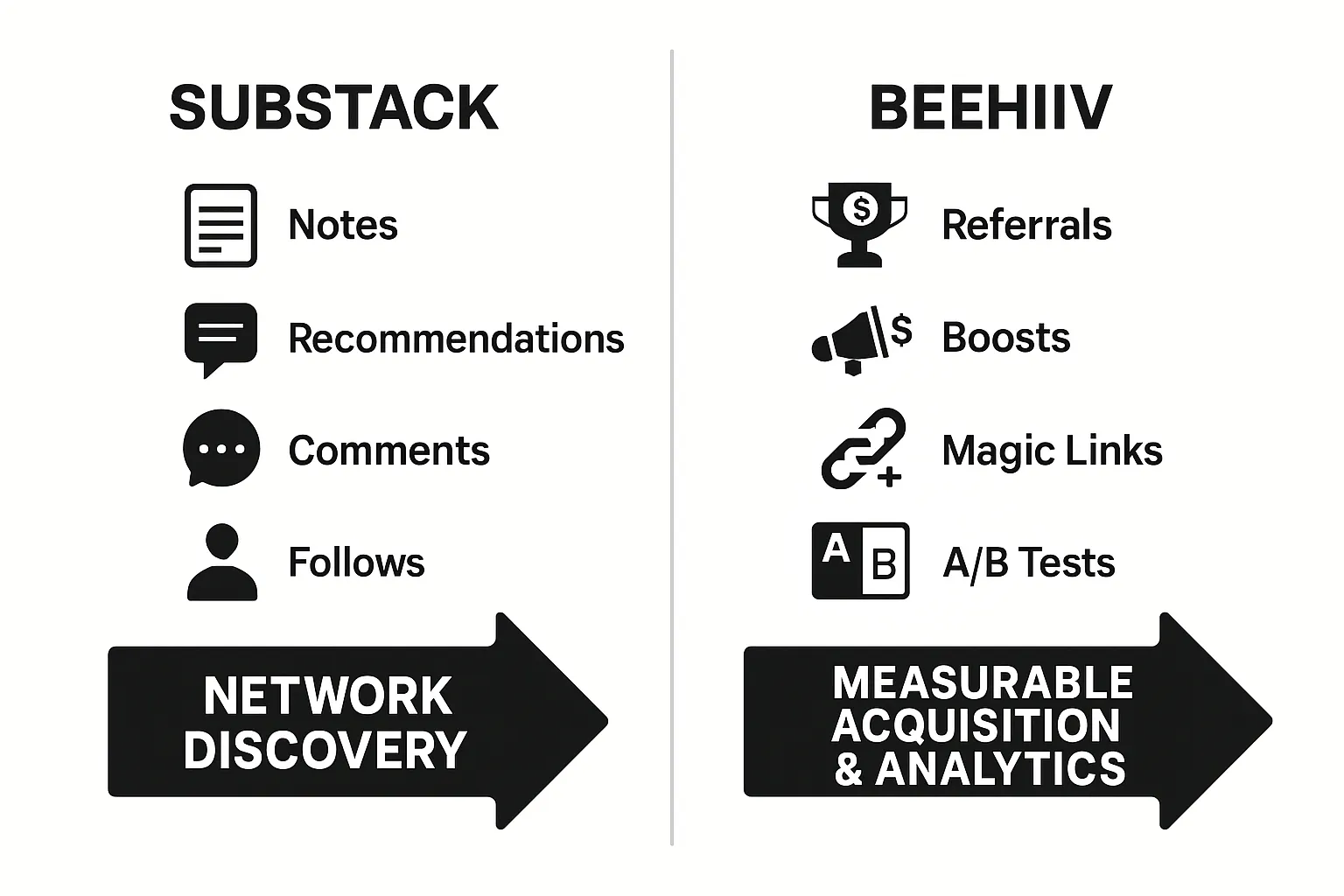
Content, editing, and publishing control
Writing experience
Substack: minimalist editor, fast to publish, supports podcasts and discussions
Beehiiv: clean editor with templates/blocks; supports email‑only posts (choose not to publish to site feed)
Publishing flexibility
Beehiiv: send newsletter‑only messages or public posts; organize archives; brand control through templates
Substack: posts appear on your publication page; toggle email delivery per post
Branding and customization
Beehiiv: more control over layout, typography, and email design
Substack: intentionally simple, limited design variance
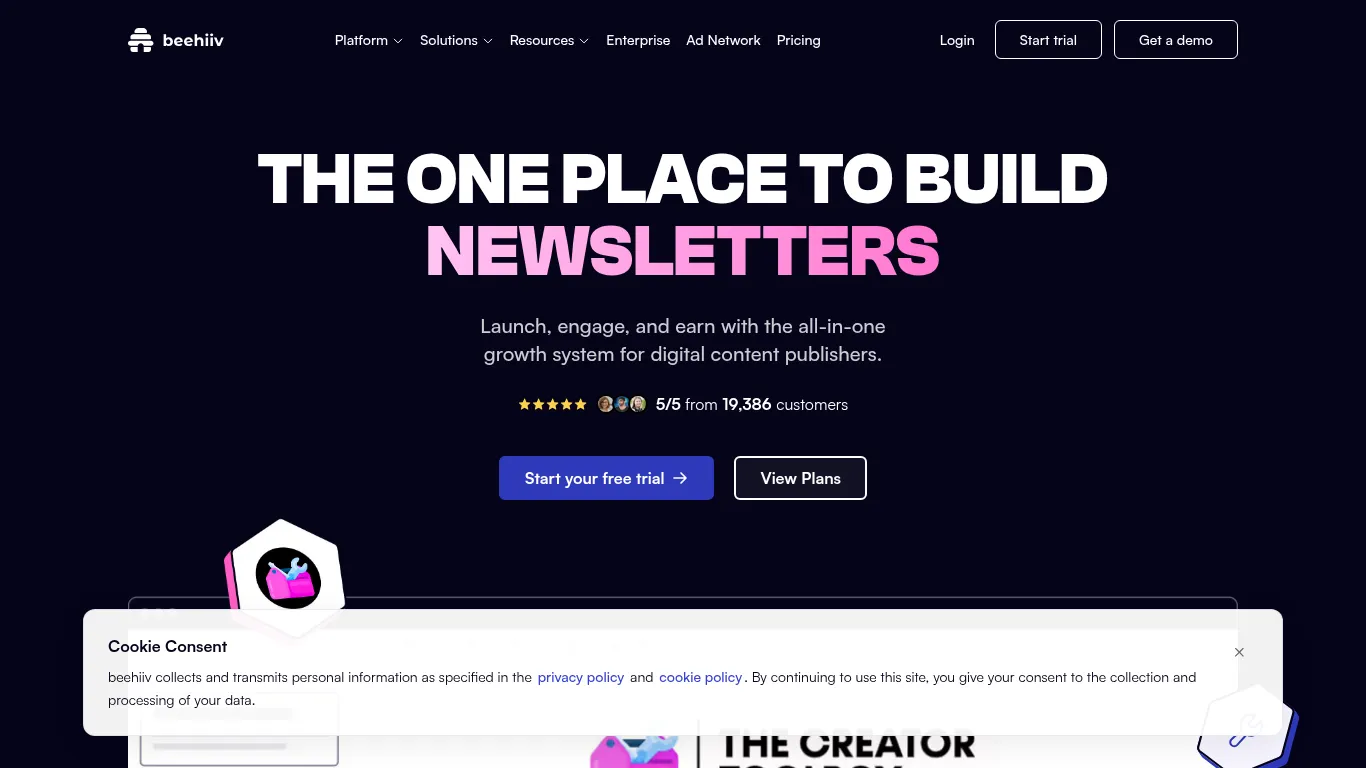
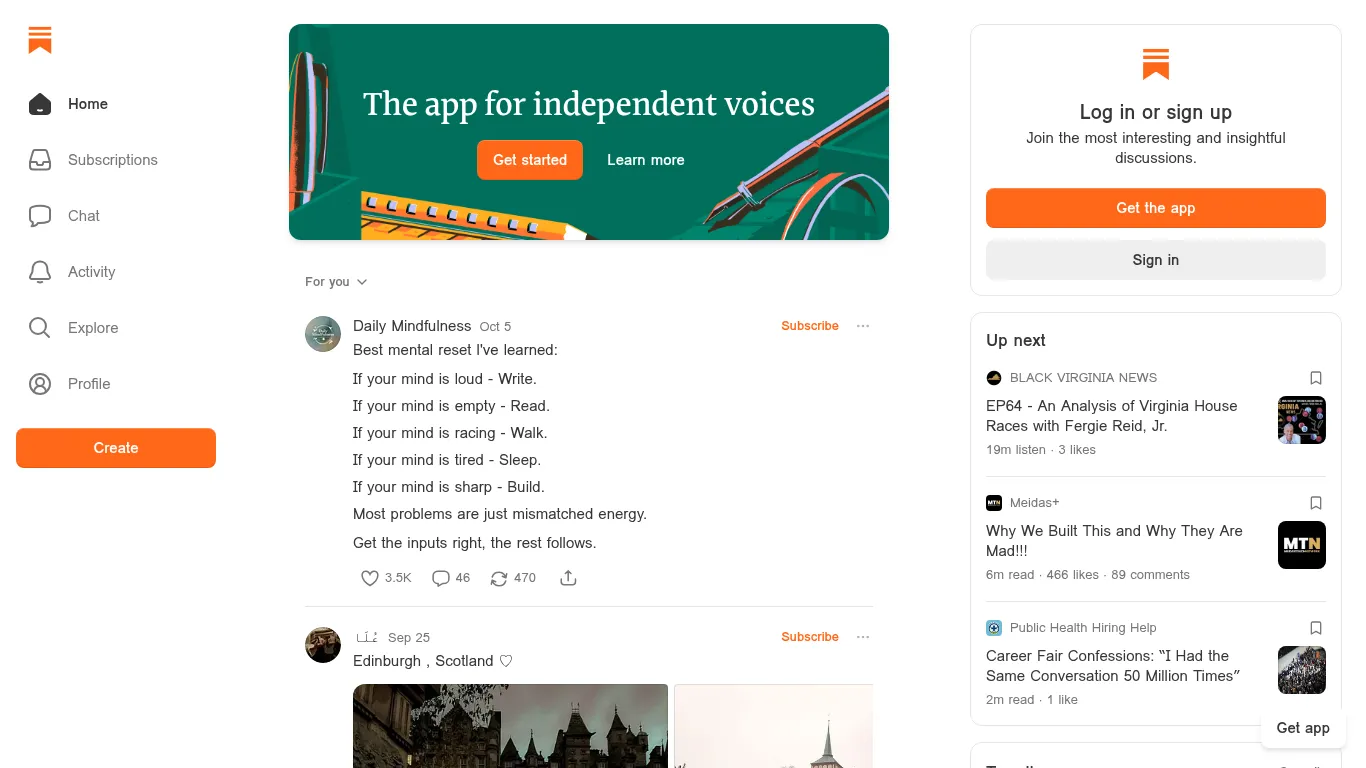
Automations, integrations, and workflows
Automations
Beehiiv: visual workflows, multi‑email sequences, triggers (paid plans)
Substack: basic welcome email; no full autoresponder builder
Integrations and API
Beehiiv: API access and popular no‑code integrations; easier to plug into a broader marketing stack
Substack: limited native integrations; best used standalone with light third‑party help
Team and multi‑pub management
Beehiiv: roles/permissions, multiple publications on higher tiers
Substack: simple contributor/admin roles for single publications
Analytics and list management
Analytics depth
Beehiiv: acquisition/source tracking, campaign performance by channel, cohort insights, and more granular dashboards
Substack: core stats (opens, clicks, growth) with limited channel/source breakdown
Segmentation and targeting
Beehiiv: rich segmentation (attributes, behaviors), send to targeted cohorts
Substack: basic filters; primarily free vs paid audience split
What this means in practice
For optimization and attribution, Beehiiv enables tighter feedback loops
For simple publishing with minimal data work, Substack is sufficient
SEO and domain control
Domains and structure
Both support custom domains and public archives; setup is straightforward
Beehiiv: finer control over what’s email‑only vs indexed posts; category organization can aid site structure
On‑page controls
Both provide the basics (slugs, metadata, alt text) and sitemaps
Beehiiv leans into site organization for newsletter‑as‑blog strategies
Practical SEO guidance
If search is a core growth channel, Beehiiv’s structure and email‑only options provide flexible content workflows
For social/network-first audiences, Substack’s discovery can offset lighter SEO control needs
Final verdict: Which should you choose? (+ an alternative)
Choose Beehiiv if
You plan to monetize through multiple streams (ads, boosts, referrals, subscriptions)
You want segmentation, automations, and detailed analytics to scale
Predictable costs (0% platform fee) matter as paid subs grow
Choose Substack if
You want the fastest path to publishing and paid subscriptions
You’ll lean on network effects (Notes, recommendations) and a writer‑centric community
You don’t need advanced automations or deep customization
A smart third option: BlogBowl
If you want an SEO‑optimized blog with a built‑in newsletter, AI‑generated daily articles, keyword research, internal linking, and privacy‑friendly analytics - all in one place - BlogBowl is designed for SaaS and startups to grow organic traffic while publishing less manually.
Ideal if your newsletter is part of a broader owned‑media strategy (blog + changelog + help docs) and you want growth on autopilot.
Bottom line
Creators who treat their newsletter like a business usually outgrow Substack’s simplicity and benefit from Beehiiv’s growth/monetization stack.
If your priority is writing quickly with a supportive network and paid subs, Substack remains a great pick.


